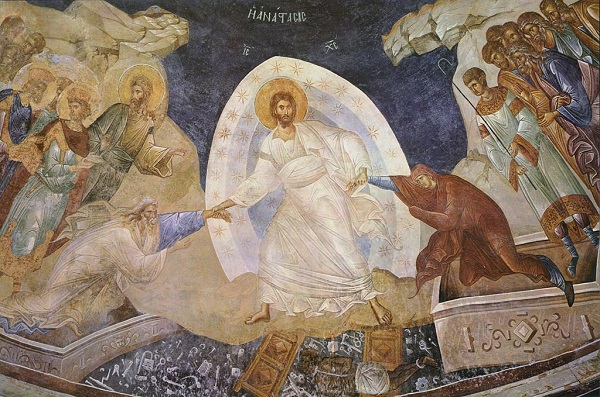The Dogma of Christ’s Descent into Hades
17 April 2020The descent in the Orthodox dogmatic system
There is evidence for the Orthodox dogma of Christ’s descent into Hades both in Holy Scripture and Sacred Tradition, though it is vague and general. Holy Scripture does not define in strictly dogmatic terms the details of the Redeemer’s descent into the kingdom of the dead, instead using general and symbolic expressions; nor did the ancient Church develop this dogma based on the Apostolic Tradition, since there was no reason to. The ancient Church Fathers occasionally made reference to the dogma of the descent, but not leave us with specific, systematic treatises concerning it. Instead, they were content to repeat the relevant passages in Scripture and the experience of the dogma in the worship and devotion of the people. Despite the lack of a specific dogmatic development of this article of the faith, it remained an essential part of the preaching of the Gospel, of the catechism and instruction of the faithful and of the Divine Liturgy. It was also included among the ancient baptismal creeds and confessions of faith and so was believed by all Christians and experienced intensely in worship. The ancient Church taught the descent into hell as an integral article of the Christian faith for the first three centuries, while in the fourth it was included in the Apostolic Creed. From then on the descent occupied a central position in ecclesiastical theology and in worship, in theory and practice and in Church life, becoming dogma at the 5th and 7th Ecumenical Synods.

It is self-evident that the dogma of the Descent into Hades was, from the outset, part and parcel of Christological dogma as a whole, which is the center and foundation of the faith, the worship, the devotion of the Orthodox and the basis of the whole of Orthodoxy. This is why the ancient Church fought against all the Christological heresies and formulated the Christological dogma with the ‘terms’ of four Ecumenical Synods: the 3rd in Ephesus in 431, the 4th in Chalcedon in 451, the 5th in Constantinople in 553 and the 6th, again in Constantinople in 680-681. The Church was concerned with the issue through these Synods and also through the great, contemporary Christological Fathers, from the 4th to the 7th centuries, the time when the Christological controversies and discussions were at their height. Because of the vital importance of Christological dogma, it became part of the rich content of Orthodox worship, making it Christocentric. The Christological dogma is the mystery of the incarnation of the Son of God and, through this, the redemption of the human race. In Himself, Christ united two perfect natures, the divine and the human, in one hypostasis of the Divine Word, ‘unconfused, immutable, indivisible and inseparable’, in the term used by the 4th Ecumenical Synod. This hypostasis, this state of being, preserves each of its qualities and energies and its wishes.
Incorporated into Christological dogma is Christ’s Descent into Hades which can be summarized briefly in this way. From the time of His death on the Cross until His resurrection, Christ descended into Hades, with His divinity united to His soul. His all-holy body remained without decay in the tomb, ‘the divinity not having deserted the body in the tomb, nor separated from the soul in Hades’ [Athanasios the Great]. Christ, in His Godhead and humanity, freely descended into Hades, with His almighty royal and redemptive authority, as victor over and destroyer of the dominion of death and its prince, ‘shattering the eternal bars which held the prisoners captive’ and proclaiming redemption to those ‘dwelling in darkness and the shadow of death’. It is important to note that all the Fathers and hymnographers of the Church who described the descent into Hades, present Christ as going down and remaining in Hades ‘freely’, ‘willingly’, ‘voluntarily’, and as victor, vanquisher and liberator of the souls that were there. In doing so, they were interpreting passages in Scripture: ‘For he broke into pieces the bronze gates, and crushed the iron bars’ (Ps. 106, 16); and ‘I will deliver them out of the hand of Hades, and will redeem them from death: where is your judgment, death? Where is your sting, Hades?’ (Hosea, 13, 14)*.
In Hades, the Redeemer preached to the departed with the aim of extending the work of His salvation to the kingdom of death, to those who would be receptive of the Gospel light. As a result the forefathers and all the holy and righteous figures in the Old Testament were saved. Many Church Fathers and theologians have taught that the words preached by Christ in Hades and, therefore, salvation extended to all the departed in general who lived good and just lives on earth, who believed in His words and accepted the salvation He offered them.






